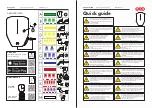
47
1-1. For safe use
1
For safety
and security
LS460/LS460L_U (OM50D48U)
Your vehicle is equipped with ADVANCED AIRBAGS designed based
on the US motor vehicle safety standards (FMVSS208). The airbag sen-
sor assembly (ECU) controls airbag deployment based on information
obtained from the sensors etc. shown in the system components diagram
above. This information includes crash severity and occupant information.
As the airbags deploy, a chemical reaction in the inflators quickly fills the
airbags with non-toxic gas to help restrain the motion of the occupants.
CAUTION
■
SRS airbag precautions
Observe the following precautions regarding the SRS airbags.
Failure to do so may cause death or serious injury.
●
The driver and all passengers in the vehicle must wear their seat belts properly.
The SRS airbags are supplemental devices to be used with the seat belts.
●
The SRS driver airbag deploys with considerable force, and can cause death or
serious injury especially if the driver is very close to the airbag. The National
Highway Traffic Safety Administration (NHTSA) advises:
Since the risk zone for the driver’s airbag is the first 2 - 3 in. (50 - 75 mm) of
inflation, placing yourself 10 in. (250 mm) from your driver airbag provides you
with a clear margin of safety. This distance is measured from the center of the
steering wheel to your breastbone. If you sit less than 10 in. (250 mm) away now,
you can change your driving position in several ways:
• Move your seat to the rear as far as you can while still reaching the pedals
comfortably.
• Slightly recline the back of the seat.
Although vehicle designs vary, many drivers can achieve the 10 in. (250 mm)
distance, even with the driver seat all the way forward, simply by reclining the
back of the seat somewhat. If reclining the back of your seat makes it hard to
see the road, raise yourself by using a firm, non-slippery cushion, or raise the
seat if your vehicle has that feature.
• If your steering wheel is adjustable, tilt it downward. This points the airbag
toward your chest instead of your head and neck.
The seat should be adjusted as recommended by NHTSA above, while still
maintaining control of the foot pedals, steering wheel, and your view of the
instrument panel controls.
Summary of Contents for LS 460
Page 13: ...13 LS460 LS460L_U OM50D48U ...
Page 32: ...32 Pictorial index LS460 LS460L_U OM50D48U ...
Page 82: ...82 1 2 Theft deterrent system LS460 LS460L_U OM50D48U ...
Page 182: ...182 3 5 Opening closing the windows and moon roof LS460 LS460L_U OM50D48U ...
Page 343: ...343 4 6 Driving tips 4 Driving LS460 LS460L_U OM50D48U ...
Page 677: ...677 5 8 Using the storage features 5 Interior features LS460 LS460L_U OM50D48U ...
Page 723: ...722 5 9 Other interior features LS460 LS460L_U OM50D48U ...
Page 875: ...874 8 2 Customization LS460 LS460L_U OM50D48U ...
Page 891: ...890 LS460 LS460L_U OM50D48U ...
















































